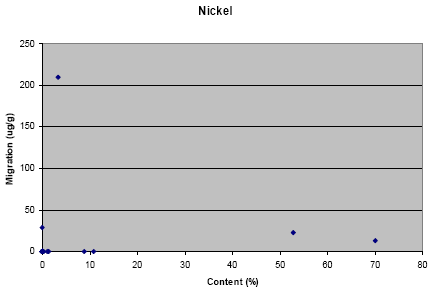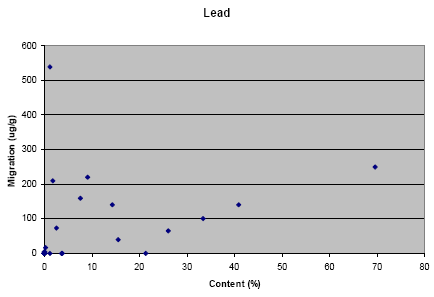Survey and health assessment of chemical substances in jewelleries
4 Migration analysis
- 4.1 Selection of metal jewellery for migration analysis
- 4.1.1 Focus on jewellery parts with low content of Pb and Cd
- 4.1.2 Even distribution of the overall categories gold, silver and non-precious metal
- 4.1.3 Even distribution in the specified product categories
- 4.1.4 Conditional distribution among types of jewellery parts and jewellery types.
- 4.1.5 Selected jewellery parts for migration test
- 4.2 Analysis method
- 4.3 Analysis results
4.1 Selection of metal jewellery for migration analysis
In total 25 jewellery parts were selected for migration analysis of metals. The reason for selecting jewellery parts and not jewellery was that jewellery as mentioned earlier consists of several separate parts with each their content (and thereby release) of metals.
The jewellery parts were selected in such a way that they covered the product types as widely as possible, yet with the primary criterion that they represented a part of the jewellery that had contact with the skin. I.e. a jewellery part as for instance a pendant belonging to an earring was not selected.
Below is a short description of the background related to the selection criteria.
4.1.1 Focus on jewellery parts with low content of Pb and Cd
The selection of jewellery for migration analysis was done among the jewellery parts that had a content of lead and cadmium respectively varying from approximately 100 ppm to the maximum measured values. The reason for this focus on jewellery that contained primarily these two metals was that it thereby became possible to select enough jewellery to illustrate a possible correlation between migration and content.
In total 15 jewellery parts were selected among the jewellery parts that contained more than 100 ppm lead and 10 jewellery parts among those that contained more than 75 ppm cadmium.
The selected jewellery parts represent the entire concentration span though focus was on the low end of the spectrum i.e. for lead between 100 and 2000 ppm and for cadmium between 75 and 2000 ppm. The reason for this was a desire to clarify how big a violation of the law it would take before a health risk could occur.
4.1.2 Even distribution of the overall categories gold, silver and non-precious metal
Since the results from the XRF-screening showed no apparent correlation between the content of heavy metals and the overall product categories: gold, silver and non-precious metal (see Table 3-15), jewellery parts were chosen that, as far as possible, were distributed evenly in the overall categories.
4.1.3 Even distribution in the specified product categories
As the screening results (Table 3-16 and Table 3-17) indicated that there was not a directly significant difference on the content of lead and cadmium in relation to the specific product categories (gold coated, silver-like etc.) jewellery parts were selected that, as far as possible, was distributed evenly among the product categories. Yet no jewellery parts were included from the category “genuine silver” because these were not in the project focus.
4.1.4 Conditional distribution among types of jewellery parts and jewellery types.
The screening results indicated that a relatively large percentage of the analysed pendants had a content of lead and cadmium respectively (see Table 3-12, Table 3-13 and Table 3-14). 70% of the analysed pendants (belonging to the product types earrings, necklaces and bracelets) showed a content of more than 100 ppm lead while for cadmium 78% of the analysed pendants had a cadmium content of more than 75 ppm. Thus, during the selection it was attempted to choose more pendants than e.g. rings and bracelets.
In addition it was attempted as far as possible to get a representative segment of the different product types (bracelet, necklaces etc.). Yet there were limited choices among the separate product types (i.e. piercing jewellery and ankle chains), which meant that a majority of the selected jewellery parts belonged to other product types (especially necklaces).
4.1.5 Selected jewellery parts for migration test
During the selection of jewellery parts for migration test it was as a main rule attempted to select jewellery parts that were distributed evenly among the selection criteria (content of heavy metals, coating, product type and type of jewellery part).
Yet in relation to the selection criterion ”content of heavy metal” a proportional larger amount of jewellery parts were selected among those that had a relatively low content of heavy metal. The reason for this was to clarify whether there could be a health related problem related to jewellery that had a content of lead and cadmium respectively close to the permitted limit.
Likewise relatively more jewellery parts of the pendant type were selected because 80% of these according to the XRF-screening contained heavy metal.
It must be pointed out that it was not possible to make a 100 % even distribution due to the limited number of purchased jewellery. In appendix K it is demonstrated how the chosen jewellery parts meet the selection criteria.
4.2 Analysis method
The 25 jewellery parts were analysed for migration of the following metals: As, Ba, Cd, Cr, Cu, Hg, Ni, Pb, Sb and Se.
The method used was ”Migration to artificial sweat” according to DS/EN 1811:2000.
The solution for artificial sweat consisted of:
1.0 g urea, 5.0 g NaCl and 0.940 µl lactic acid dissolved in 1 litre of demineralised water. pH was set to 6.5 and the extraction was made at 40 degrees.
Sample pieces (2 g) with a variable area was placed in 25 ml artificial sweat and placed at 40 °C for 4 hours. Afterwards the water phase was decanted from the sample pieces. Subsequently the water phase was analysed for content of emitted metals by optic emission spectrometry (ICP-OES). The identified contents were given in relation to sample weight (µg extracted metal per gram sample) as well as in relation to the surface of the sample (µg extracted metal per cm²).
After cutting of the jewellery part, the exposed side was covered with wax in order to make sure that migration only happened from the parts of the sample which were coated or alloyed with precious metals.
As detection limit was used what resembles 5 times the detection limit for the ICP-OES analysis.
Duplicate determination was performed on all tests. Yet two jewellery parts (both ear pins) were so small, that sample pieces on 2 x 2 g could not be extracted. In these two cases a smaller sample weight was used and the detection limit was estimated to be the actual sample weight.
In some cases the duplicate determinations were not in concordance. In these cases the analysis of metals was repeated using the ICP-OES, though without any deviation from already found results.
The measurement of the area on the samples took place by individual measurement and following calculation. As the jewellery varies a lot in their design it can be difficult to measure the area precisely and therefore the measurement of the area took place with some approximation.
4.3 Analysis results
The results for migration to artificial sweat calculated in relation to sample weight (µg extracted metal per gram sample) are presented in Table 4-1. The values represent the average value for the duplicate determinations. In cases where the two determinations deviate significantly from each other both values are presented.
Table 4-1: Results from migration analysis (artificial sweat) of metals from 25 jewellery parts. The values are calculated as metal release per gram jewellery part. Blank fields indicate samples where the migration did not exceed the detection limit (The detection limit varied between 0.25 – 2.5 depending on the metal and is given in appendix H).
| Jewellery part no. | Description of jewellery part | As | Ba | Cd | Cr | Cu | Hg | Ni | Pb | Sb | Se |
| Unit: µg/g | |||||||||||
| 169.1 | Pendant | 0.2/11 | 0.5/23 | 17 | |||||||
| 164.1 | Heart backside | 2.6 | 2/4 | ||||||||
| 152.2 | Matt ring | 0.46 | |||||||||
| 138.1 | Pendant from behind | 2.4 | 0.57 | 150/210 | |||||||
| 136.2 | Disc | 1.2 | 0.81 | 100 | |||||||
| 130.1* | Needle | 25/1300 | |||||||||
| 125.1 | Fingerring | 0.86 | 0.73 | 0.5/29 | 93/540 | ||||||
| 107.1 | Chain with balls | 53 | |||||||||
| 101.3 | Cornet | 16/34 | |||||||||
| 101.1 | Backside of heart | 1.5 | 73 | ||||||||
| 99.2* | Non-twisted part | 150/220 | |||||||||
| 99.1 | Twisted rings | 160 | |||||||||
| 95.3 | Catch | 3.3 | 250 | ||||||||
| 91.1 | Big ball | 26/160 | 90/210 | ||||||||
| 91.3 | Chain | 16/28 | 13 | ||||||||
| 88.1 | Ring without stone | 0.6/16 | 2.3 | 2 / 5 | |||||||
| 70.3 | Catch | 1.5 | 140 | ||||||||
| 70.1 | Pendant | 0.31 | 0.50 | ||||||||
| 68.1 | Ring | 3.8 | 0.89 | 140 | |||||||
| 62.1 | Pendant | 3.0 | 0.67 | 39 | |||||||
| 60.1 | Bracelet | 3.4 | |||||||||
| 56.1 | Pendant backside | 2.1 | 23/64 | ||||||||
| 38.1 | Jewellery without stone | 12 | 0.59 | 220 | |||||||
| 26.2 | Catch | 0.44 | |||||||||
| 6.1 | Angel | 21 | 0.30 | 6/160 | |||||||
NB. Samples marked with * have been performed with an adjusted detection limit due to reduced sample size.
Results for migration to artificial sweat calculated in relation to sample area (µg extracted metal per cm²) are presented in appendix J.
Figure 4-1: Migration of respectively Cd, Cu, Ni and Pb in relation to the content of the respective metals (according to the XRF-screening) in the jewellery.




NB: In samples where the duplicate determination deviated significantly the highest value has been used.
As it is shown in Figure 4-1 there is no immediate relation between the migration and the content of the different metals. i.e. it is not possible to assume that a high concentration of the metal in jewellery gives a high migration. It must be noted though that for jewellery where the content of lead is less than approximately 1% hardly no migration has occurred. A similar tendency was not observed for the other metals (see appendix L).
There are too few pieces of jewellery in the migration analysis for it to be possible to conclude any relation between the jewellery parts, the jewellery type and the jewellery categories.
Version 1.0 October 2008, © Danish Environmental Protection Agency